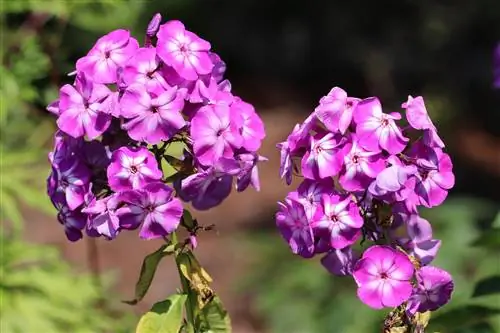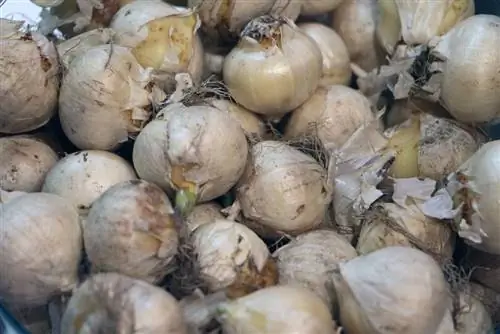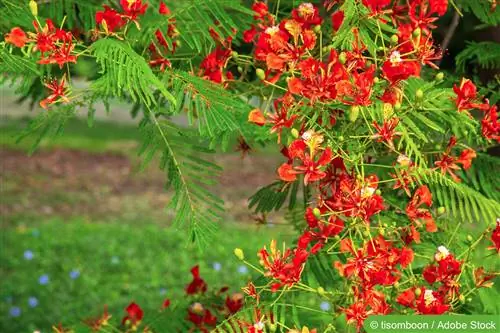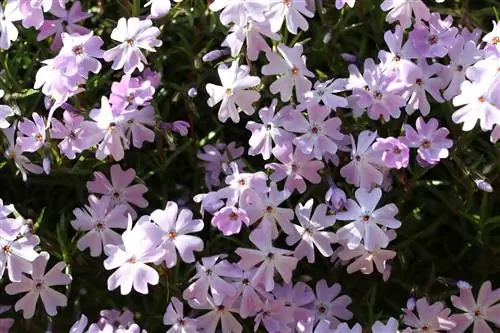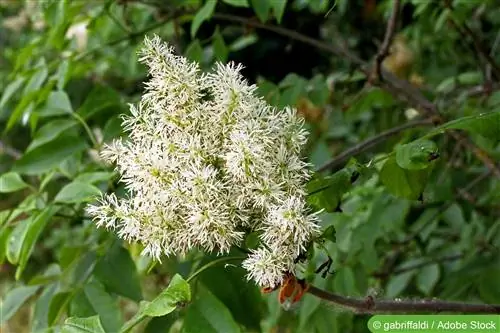- Author admin [email protected].
- Public 2023-12-17 03:39.
- Last modified 2025-06-01 06:48.
The flame flower makes its big appearance in July. With the right variety planting, you can have wonderful flowers well into autumn. Not only the scent of the phlox but also the wonderfully strong colors as well as the pastel tones enchant every gardener's heart.
Phlox can be found in many cottage gardens. It is the image of the rural and should not be missing in any garden. The phlox thrives particularly well in a climate with a lot of precipitation and cool weather. Phlox gets its name from ancient Greek, meaning “flame”. Because it produces brightly colored flowers, the plant was given the German name Flame Flower, which is rarely used. Wild phlox is found in rainy areas of North America, particularly in lowlands that have mineral-rich soils, especially along rivers. The flame flower is an Eldorado for butterflies, bees and bumblebees. Since they offer a wide variety of colors, they can be arranged with various garden flowers. Perfect companions are asters, delphiniums or roses.
Flame Flower Location
The flame flower thrives particularly well in a partially shaded to sunny location. The perennial grows up to one and a half meters tall. The soil should be moist, well-drained and rich in compost. The phlox is a shallow-rooted plant, so regular watering is important, especially in high heat. Phlox prefers a sunny location (but not in full sun). The flowers of the flame flower really light up in a shady environment. The phlox particularly likes to fertilize with compost, horn meal and nettle manure in spring and especially before flowering. The flame flower doesn't like to give away its location. It can stay in the same place for up to ten years. If you plant the perennial too deep, it may not bloom.
The correct distance when planting should be around three to five plants per square meter. The plant spacing should be 50 - 80 cm. If the phlox doesn't get into the right location, it can take three to four years until it really gets going. If you put the phlox in a different place because it isn't blooming properly, it should be cooler and moister than the previous one. The best time to plant is early spring or autumn.
- moist soil, permeable and rich in compost
- don't like the blazing sun
- cool and damp location
- Maintain planting distance
- Planting time in spring or autumn
Care and propagation of the flame flower
The Phlox is robust and long-lasting, and also frost-hardy, even in severe winters and late frosts. During the growth phase, especially in April and May, watering should be carried out regularly in dry conditions. Nutrient-rich soil that must be kept moist is all the phlox needs. If natural fertilizer is not available, you can fertilize with a slow-release fertilizer rich in phosphorus. If you break off the spent umbels, the perennial will begin to bloom a second time. Pruning should be done in late fall or early spring.
Propagation is best done by dividing the rhizomes in spring, or after flowering in autumn. The propagation of root cuttings has also proven to be very good and successful. Self-sowing is also possible if the dead flowers are not cut off. However, plants that germinate from seeds are usually not true to the variety.
Diseases of Phlox
The flame flowers impress with their wonderful flowers and a breathtaking scent, but they are susceptible to diseases and pests. You can combat this a little by choosing robust varieties. 'Düsterlohe', 'Rosa Pastel', 'Elfe', 'Judy', 'Pünktchen' or 'Pallas Athene', to name just a few, are among the strong and less susceptible perennials. Among the diseases, powdery mildew is common, which can spread from the leaves to stems and flowers. Here you should combat it with fungicides or mildew spray.
Leaf spot disease can also affect the phlox. This is a fungal disease that causes the leaves to yellow and die. If the leaves show red-violet spots, it is leaf spot disease, for which there are no direct remedies. But you can also combat leaf spots with remedies against other fungal diseases.
Stem rot, which appears at the base of the stem, is also a viral disease. Leaf curling, greening of flowers or thickening of stems are signs of stem rot. Here you should remove the affected plants from the garden and destroy them. Then there is stick disease. Here the plant is attacked by very small worms, the so-called stemworms. Shortened shoots, overgrown leaves and misshapen flowers are signs of cane disease. The diseased shoots should be removed.
Different flowering times
Depending on which flame flower you choose, you have different blooming times. The meadow phlox blooms from June to August with white, purple or pink flowers that grow up to 1 m high. The early summer phlox shows its flowers from June to July and grows to a height of 60 cm. Purple-red, white with red, light purple with pink are the wonderful flowers that thrive particularly well in partial shade. There are also phlox that can be planted in the rock garden. These have a cushion-shaped growth and grow over stones and walls. But plants in pots or roof gardens are also ideal. The fragrant phlox is the diva among phloxes. White and pink, violet-blue are the colors that create decorative accents in the perennial bed.
Cutting the Flame Flower
The flame flower needs a lot of care. Regular fertilization increases growth and flowering power. The ideal time for this is in April/May and before flowering in July. Spent flowers should be cut back in autumn. A complete cut down to 10 cm should be done in autumn.
What you should know about the flame flower in brief
- The flame flower is a hardy plant, but not so easy to care for. With its intoxicating scent, it attracts butterflies, bumblebees and bees during the flowering period. The flowering period lasts until autumn. The phlox should not be missing in any garden.
- Phlox is one of the most popular perennials in German gardens. The variety of varieties makes every bed appear in a colorful sea of flowers.
- Phlox is one of the heavy-feeding perennials. It thrives best in nutrient-rich, permeable, deep loamy soil. Always water sufficiently!
- Ideal location is sun to partial shade, without blazing midday sun. Regular fertilization is absolutely necessary. Nettle manure, bone or horn meal, or with mature compost are suitable for this.
- Phlox is unfortunately very susceptible to powdery mildew, mineral fertilizers with a high nitrogen content further increase this susceptibility.
- The flowering begins in June and lasts well until October, of course the flowering time can also depend on the variety.
Phlox is now available in many different colors, including two-tone. Some new varieties are said to be less susceptible to disease: These varieties include 'Orange', or 'Pastorale', with their beautiful salmon-colored flowers. The 'Pax' variety with its pure white flowers is also less susceptible. The scent of phloxes is most noticeable in the evening, but only when it is really hot. Her scent is very pleasant. Ideal plants in the vicinity of phlox are fine-rayed asters, bluebells, gemsbane, but also delphiniums, daylilies, suneyes and summer daisies. Phlox is absolutely hardy and needs no protection at all.
Phlox tends to rise out of the ground after a few years. Cover with compost and soil mixture. You can also take the canes out of the ground, divide them and replant them, but don't plant them too deep, otherwise they may not bloom. Regularly removing dead flowers encourages the formation of more flowers. If you shorten half of the shoots by a third in early summer, the flowering period will be extended.

